Traveling with a baby can feel overwhelming, but it doesn’t have to be stressful. SIXT.VN understands the challenges and offers solutions for a smooth and enjoyable trip. By packing the right Infant Travel Essentials, you can ensure comfort and safety for your little one. Consider SIXT.VN for reliable transportation, comfortable accommodations, and local insights, making your Vietnam adventure truly unforgettable.
1. When is the Best Time to Travel Long Distances with an Infant?
Ideally, wait until your baby is at least three months old before taking longer trips. This allows their immune system more time to develop and they are generally more comfortable with car seat travel.
Waiting until your baby is around three months old offers several advantages. According to a study by the American Academy of Pediatrics, infants’ immune systems are still developing in the first few months of life. Delaying travel until after this period reduces the risk of exposing them to illnesses. Moreover, by three months, babies often have more predictable sleep schedules and feeding routines, making travel logistics more manageable. This period also provides time for them to adjust to car seats, which can be crucial for longer journeys. While individual circumstances vary, this guideline provides a safer and more comfortable travel experience for both parents and baby.
2. What are the Basic Infant Travel Essentials You Should Pack?
Essential supplies include diapers, baby wipes, surface wipes, snacks, clothes, and extra diapers. It’s always wise to bring more of the basics than you think you’ll need, especially diapers, to avoid unexpected shortages.
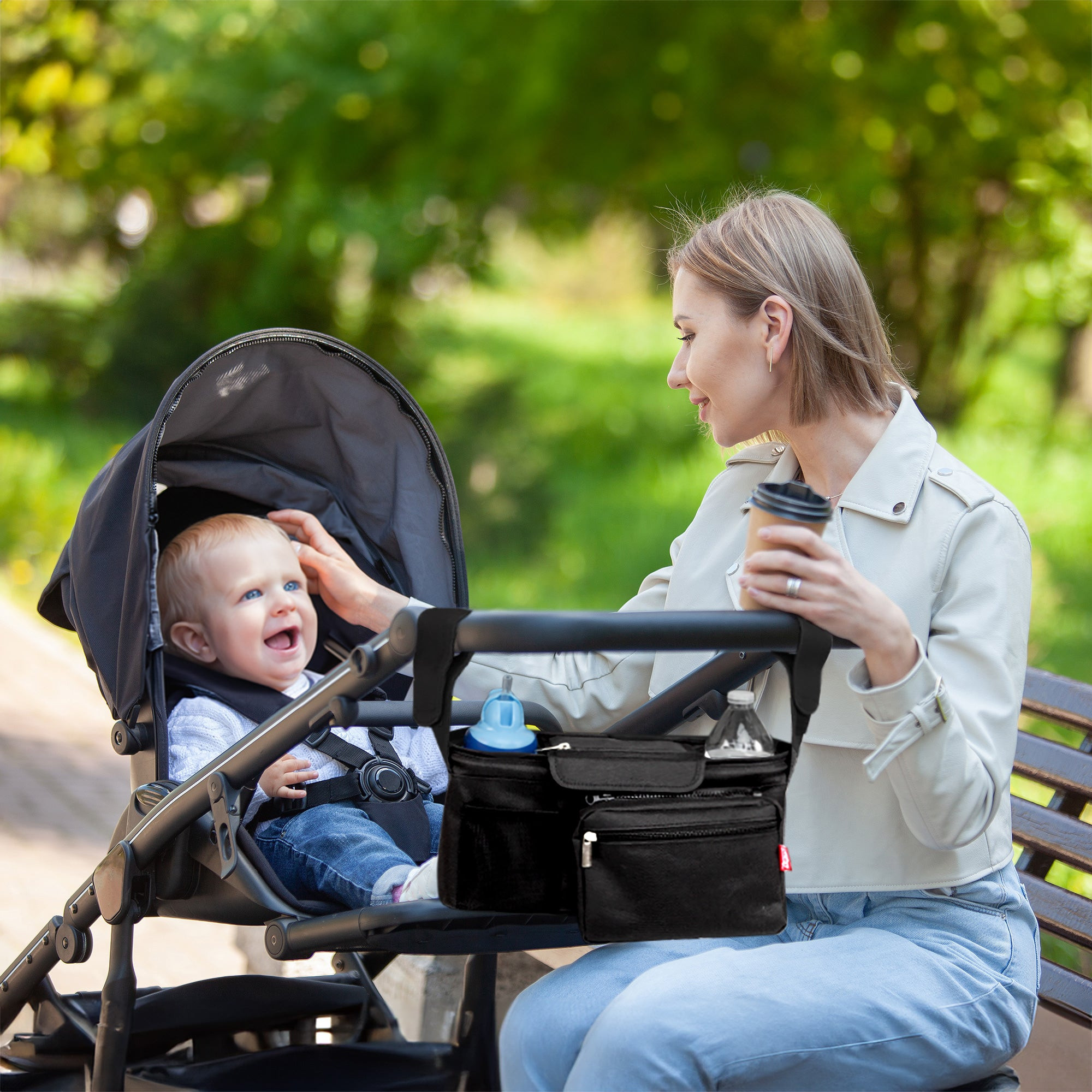 Mother on park bench playing with her baby who is laughing in a stroller.
Mother on park bench playing with her baby who is laughing in a stroller.
The core of your baby travel kit should address hygiene, nourishment, and comfort. Pack a generous supply of diapers and baby wipes to maintain cleanliness, and include surface wipes to sanitize public areas. Always have an ample supply of snacks and baby food to keep your little one content, especially during delays. Extra clothes are crucial for handling spills and accidents. According to a survey by the National Diaper Bank Network, many families struggle with diaper need, so ensuring you have enough is essential. Keeping these basics well-stocked can prevent stress and discomfort during your trip.
3. How Can a Diaper Bag, Stroller Organizer, and Changing Station Help While Traveling with an Infant?
A well-stocked diaper bag and a portable changing pad are vital for any trip with your baby. Your diaper bag should include essentials like diapers, wipes, diaper cream, and extra clothes. A portable changing station ensures you have a clean, convenient surface for diaper changes on the go. A high-quality stroller organizer is another must-have.
A well-organized diaper bag acts as your command center, keeping all baby essentials within easy reach. A portable changing station provides a hygienic surface, protecting your baby from germs in public restrooms or rest areas. A stroller organizer keeps frequently used items like bottles, wipes, and snacks accessible, reducing the need to rummage through a larger bag. Research from the World Health Organization highlights the importance of hygiene in preventing infections, making these tools invaluable for travel. These accessories provide convenience and promote a healthier environment for your baby.
4. Why are a Baby Carrier, Stroller, and Car Seat Important for Infant Travel?
Bringing a baby carrier, stroller, and car seat ensures your baby’s safety and your convenience during travel. A stroller is perfect for longer outings, while a car seat is required for car travel. A hands-free baby carrier is another great call, if you can swing it. It allows you to keep your baby close while keeping your hands free for other tasks.
These three items cater to different needs. A car seat is non-negotiable for road safety, adhering to legal requirements and protecting your child in transit. According to the National Highway Traffic Safety Administration (NHTSA), proper car seat usage significantly reduces the risk of injury in a crash. A stroller provides comfort and convenience for longer walks, allowing your baby to rest while you navigate airports or tourist spots. A baby carrier keeps your baby close, offering comfort and security while freeing up your hands. This combination of tools ensures that your baby is safe, comfortable, and easily manageable throughout your journey.
5. In What Ways are Blankets & Swaddles Indispensable When Traveling with an Infant?
Blankets and swaddles provide cozy warmth, doubling as nursing covers, changing mats, or sunshades. Be sure to pack a few lightweight and easily washable options to keep your baby cozy and secure.
Blankets and swaddles are versatile tools that address multiple needs. They provide warmth in cooler environments, serve as nursing covers for discreet feeding, act as makeshift changing mats, and offer shade from the sun. According to pediatricians, swaddling can also help soothe infants by mimicking the feeling of being held, promoting better sleep. Lightweight and easily washable options are practical for travel, ensuring quick cleanup after spills or accidents. Their compact size and multiple uses make them indispensable for ensuring your baby’s comfort and security on the go.
6. How Can a Nursing Pillow Be a Lifesaver During Travel?
A nursing pillow provides both you and your baby with comfort and support during feedings. Plus, it’s super useful for tummy time while you’re away from home. Nursing pillows help maintain a good nursing position, reducing strain on your arms and back.
A nursing pillow provides essential support, making feeding sessions more comfortable and efficient. It elevates your baby to a comfortable feeding height, reducing strain on your arms, back, and neck. This is particularly helpful when traveling, where you may not have ideal seating arrangements. Additionally, a nursing pillow can be used for tummy time, promoting your baby’s motor skills. Lactation consultants often recommend nursing pillows to help mothers maintain a good nursing position, ensuring effective milk transfer and reducing discomfort. This simple tool can significantly enhance the feeding experience while on the move.
7. Why are Soothing & Teething Toys Essential for Keeping Your Baby Calm and Content During Travel?
Soothing and teething toys, including binkies and pacifiers, are essential for keeping your baby calm and content during travel. These items help soothe your baby’s discomfort from teething and provide familiarity in new environments. Pack a few of your baby’s favorites to ensure a peaceful journey.
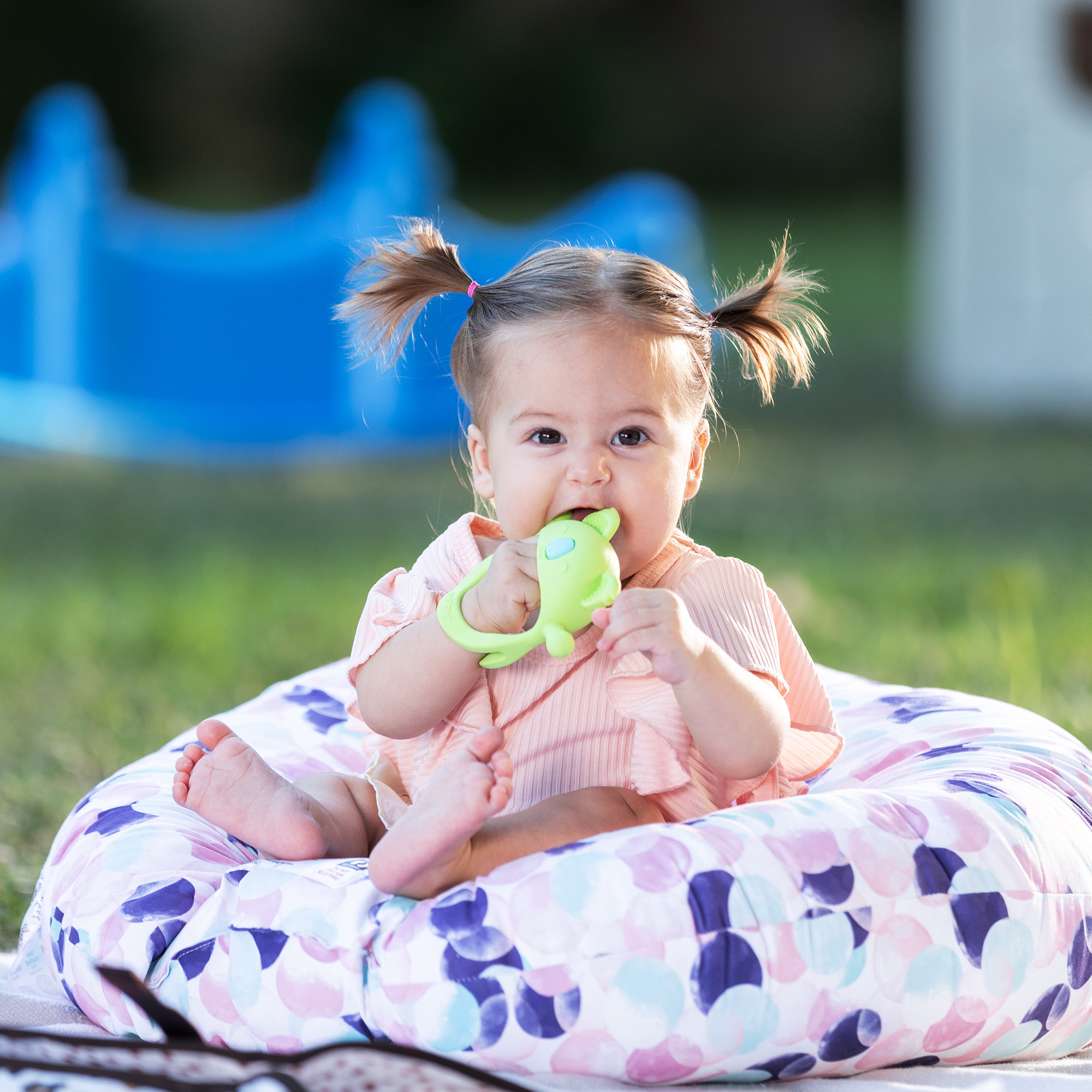 Baby girl sitting on a pillow chewing on a green koala Nuby Silicone Wrist Teething Mitten.
Baby girl sitting on a pillow chewing on a green koala Nuby Silicone Wrist Teething Mitten.
Familiar toys and comfort items can be incredibly reassuring for babies in new environments. Sucking on a pacifier or chewing on a teether can help relieve anxiety and discomfort, especially during flights or long car rides. The American Academy of Pediatrics notes that pacifiers can also reduce the risk of Sudden Infant Death Syndrome (SIDS), making them a practical and comforting travel companion. By packing a selection of your baby’s favorite soothing items, you can create a sense of normalcy and security, promoting a more peaceful and enjoyable travel experience.
8. How Do a Bib, Feeding Utensils & Suction Plate Contribute to Hassle-Free Meals While Traveling with an Infant?
If your little one has started solids, a bib, feeding utensils, and a suction plate are crucial for hassle-free meals while traveling. These items help keep meals clean and organized, preventing spills and messes. A portable high chair booster seat ensures your baby can join you at the table, especially if your road trip includes a few mealtime pit stops. This makes feeding time smoother no matter where you are.
Having the right feeding gear can significantly simplify meal times on the go. A bib protects your baby’s clothes from spills, while appropriately sized utensils make feeding easier and more efficient. A suction plate prevents the dish from sliding, reducing messes and frustration. A portable high chair booster seat ensures your baby has a secure and comfortable place to eat, no matter where you are. Pediatric nutritionists emphasize the importance of maintaining a consistent feeding routine, and these tools help you do just that, promoting a positive and stress-free mealtime experience.
9. Why Should You Bring Toys, Books & Comfort Items When Traveling with an Infant?
New toys are especially worthwhile, as they’re more likely to engage your child’s interest as opposed to something they’ve played with time and time again. Naturally, you should still bring a few of their favorite toys and comfort items to provide some ease during your time away from home.
Toys, books, and comfort items provide entertainment and emotional support for your baby during travel. New toys can capture their attention and provide novel stimulation, while familiar favorites offer comfort and security in unfamiliar surroundings. According to child development experts, engaging toys and books can also promote cognitive development and language skills. Packing a variety of items ensures that you have options to keep your baby occupied and content, helping to minimize fussiness and boredom throughout the journey.
10. What Other Essentials Should You Consider Based on Your Baby’s Needs?
Don’t forget other essentials that can vary based on your baby’s needs, such as medical supplies, a bottle warmer, and a breast pump. Having a small first aid kit with medications and basic medical items is important for any minor health issues. A bottle warmer and breast pump ensure that feeding is convenient and stress-free, especially when you’re away from home.
Additional essentials depend on your baby’s specific needs and health conditions. A small first-aid kit with essentials like antiseptic wipes, bandages, and pain relievers can address minor injuries or discomfort. If your baby uses specific medications, ensure you have an ample supply and any necessary prescriptions. A bottle warmer provides a convenient way to prepare formula or breast milk, while a breast pump allows nursing mothers to maintain their milk supply and feed their baby on the go. Consulting with your pediatrician before traveling can help you identify any additional medical supplies or precautions you should take, ensuring your baby’s health and well-being throughout the trip.
11. How Can Destination-Specific Items Improve Your Infant Travel Experience?
You may need unique items depending on where you’re going and what you’ll be doing. For instance, if you’re at the beach or spending a lot of time outdoors, bring a hat, sunblock, and a means for shade. You’ll also want to consider stroller accessories like insect netting or a weather shield. Bring clothes appropriate for the weather of your destination.
Destination-specific items ensure your baby is comfortable and protected in any environment. If you’re visiting a sunny location, pack a wide-brimmed hat, baby-safe sunscreen, and lightweight, breathable clothing to prevent sunburn and overheating. In areas with insects, bring insect netting for strollers and baby-safe repellent. For colder climates, pack warm layers, hats, and mittens to protect against the cold. Additionally, consider bringing any specialized gear needed for activities like swimming or hiking. Tailoring your packing list to the specific conditions of your destination ensures your baby’s comfort and safety, making for a more enjoyable travel experience.
12. Is There a Baby Travel Essentials Checklist?
Yes! To make things easier for you, we’ve grouped the above items into a handy checklist. We hope this makes preparing for your next trip a little easier.
Baby Travel Checklist
Most Important
- Basic Supplies
- Diapers
- Diaper cream
- Baby wipes
- Surface wipes
- Baby food and snacks
- Extra clothes
- Portable changing station
Very Important
- Travel
- Baby carrier
- Stroller
- Car seat
- Sleep & Nursing
- Nursing Pillow
- Lightweight blankets
- Washable swaddles
- Feeding
- Bibs
- Feeding utensils
- Suction plate
- Portable high chair booster seat
Important
- Soothing & Teething
- Teethers
- Binkies / pacifiers
- Toys, Books & Comfort Items
- New toys
- Favorite toys
Extras
- Toothbrush
- Small first-aid kit
- Medications
- Bottles
- Bottle warmer
- Breast pump
Destination Items
- Weather-appropriate clothes
- Hat
- Sunblock
- Means for shade (if outdoors/beach)
- Stroller accessories
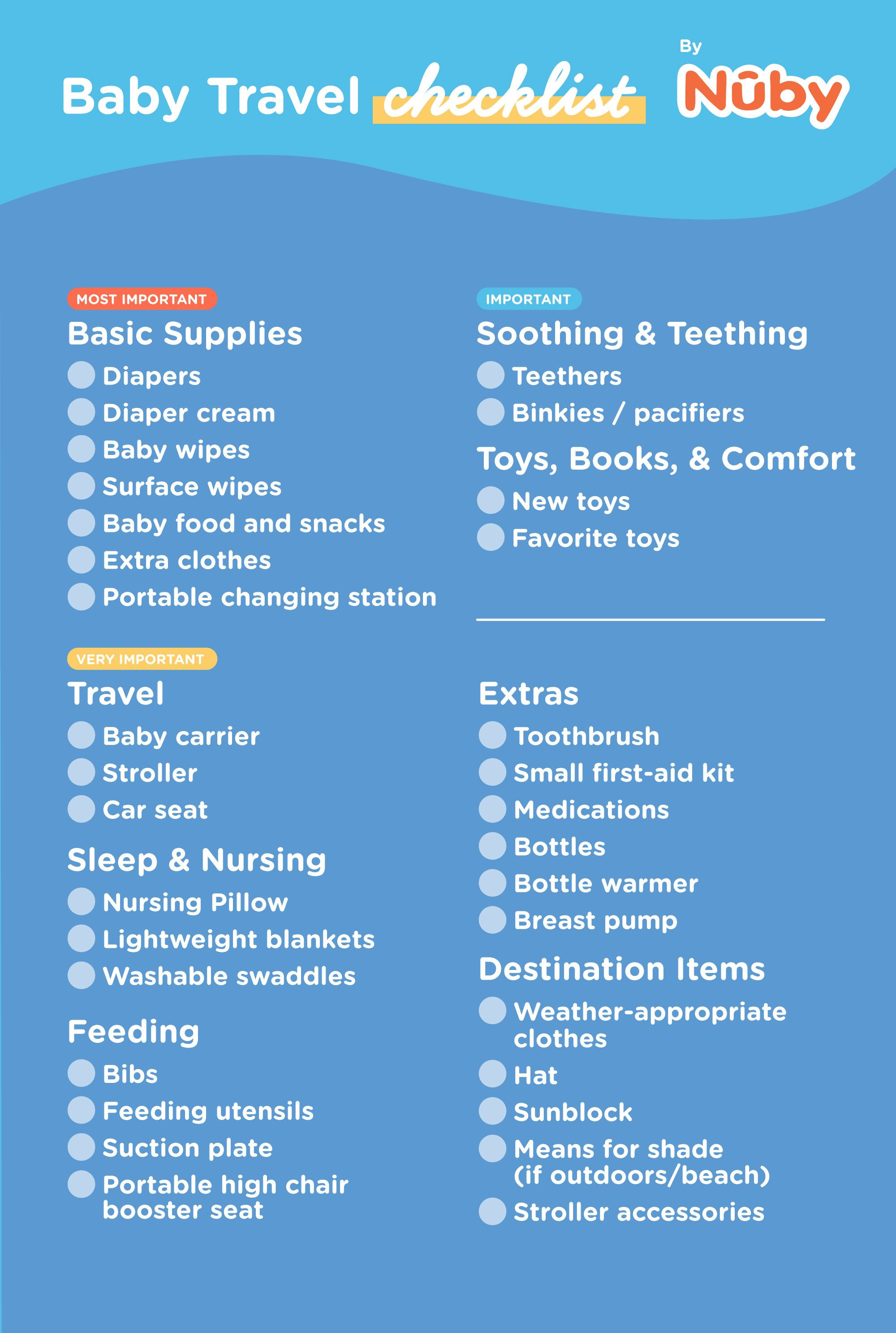 Nuby Baby Travel Checklist
Nuby Baby Travel Checklist
Having a checklist ensures you don’t forget critical items, reducing stress and improving preparedness. Organizing the checklist into categories—most important, very important, important, and extras—helps prioritize packing. Including destination-specific items ensures you’re prepared for the unique conditions of your travel location. Utilizing a checklist promotes efficiency and thoroughness, minimizing the risk of overlooking essential items and contributing to a smoother, more enjoyable trip.
13. What Else Should You Consider When Taking Longer Trips With Your Baby?
There’s more to long-distance travel with a baby than what to bring. Here are a few more tips to consider when taking your infant with you on their first big trip.
Beyond packing, consider the logistics of your travel method and the needs of your baby. Plan for frequent breaks, entertainment, and comfort.
14. How Does Your Mode of Transportation Affect Your Infant Travel Plans?
Your mode of transportation may change how you have to approach your trip. While there are plenty of ways to travel with your baby, most parents will be traveling by car or airplane.
The mode of transportation significantly impacts your travel planning. Car travel offers flexibility but requires frequent stops for breaks and diaper changes. Air travel necessitates navigating airport security, managing cabin pressure, and adhering to airline regulations regarding infant seating and baggage. According to the Federal Aviation Administration (FAA), infants under two years old can travel on a parent’s lap, but securing them in a car seat is safer. Consider the advantages and disadvantages of each mode to tailor your packing list and travel strategies accordingly.
14.1 What are Some Road Trip Tips When Traveling with an Infant?
Don’t rush it. Be prepared for a longer trip than normal. For longer trips, it’s a good idea to plan on staying in a hotel overnight and it’s better to assume you’ll need two days to reach your destination.
Patience is the name of the game, as you need to focus on keeping your baby safe, happy, and comfortable.
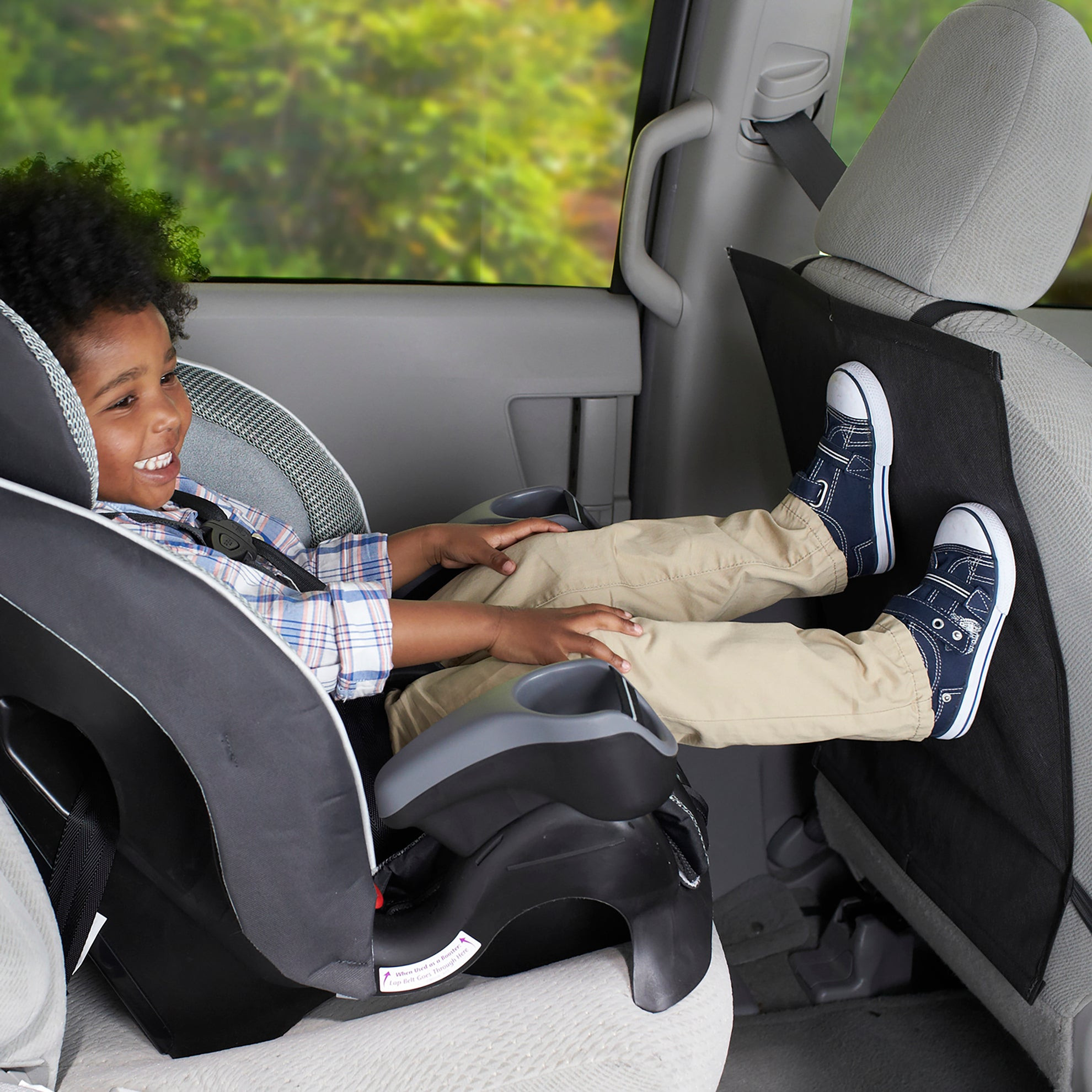 Toddler sitting in car seat with feet pressed against a Nuby Kick Mat on the seat in front of him.
Toddler sitting in car seat with feet pressed against a Nuby Kick Mat on the seat in front of him.
Take breaks every two hours or less. Babies shouldn’t spend more than two hours in a car seat at a time. You’ll need time to feed, change diapers, and take breaks for play or tummy time. If you’re hoping to keep a good pace, you can keep these breaks to 15-30 minutes, but longer breaks are typically better.
Plan your stops in advance, if you can. This should make things far more manageable.
Keep the baby entertained. Have someone join your little one in the back seat to play games and peek-a-boo. This will help pass the time for both baby and mom or dad. You can also try timing your drive around baby’s sleep schedule to take some of the pressure off.
Bring the right car accessories. Pop open car sunshades for windows are a great idea, as are car organizers.
You’ll also want a car mirror to keep an eye on your baby from the front seat. This can be especially helpful if you’re unable to have someone join them. Either way, it’s a must-have for road travel – even if you’re taking shorter trips.
That said, if your destination’s far enough… have you considered flying?
Plan frequent stops to allow your baby to stretch, feed, and have diaper changes. Keep them entertained with toys and books. Consider driving during their sleep times.
Don’t Rush: Accept that the trip will take longer than usual and adjust your schedule accordingly.
Regular Breaks: Stop every two hours to allow the baby to move, feed, and be changed.
Entertainment: Bring toys, books, and music to keep the baby occupied.
Car Accessories: Use sunshades to protect from the sun and a mirror to keep an eye on the baby.
Timing: Plan your travel around the baby’s sleep schedule to minimize fussiness.
14.2 What are Some Air Travel Tips When Traveling with an Infant?
Gate check your stroller. This can be helpful, as you’ll have it with you at the airport, making it way easier to get around. Many airlines will let you do this for free, but you should still check ahead of time.
Change your baby before you board. Aim to change your little one’s diaper as close as you can to boarding as possible. This can help you avoid one more on-the-plane diaper change, which should make life at least a little easier.
Feed during takeoff and landing. Whether you’re breastfeeding or bottle feeding your young one, proper timing can make the flight more restful. Aim to feed during takeoff and landing to help your child’s ears equalize.
Soft Sounds Baby Earmuffs can make air travel more pleasant for little ones who are more sensitive to loud noise.
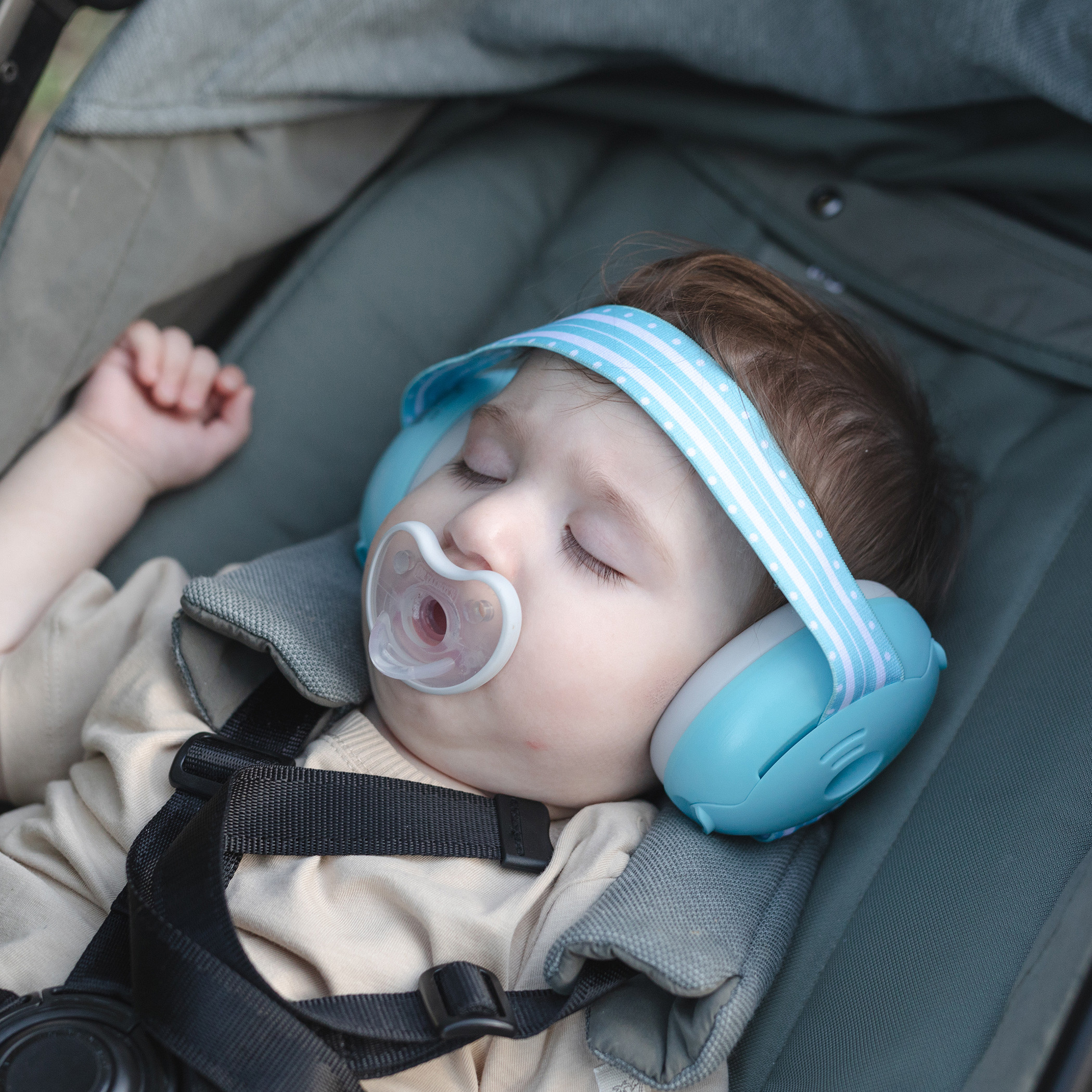 Sleeping baby with pacifier wearing Nuby Soft Sounds Baby Earmuffs.
Sleeping baby with pacifier wearing Nuby Soft Sounds Baby Earmuffs.
Get your baby their own seat if you can. For a safer, easier trip, get your little one their own seat for the flight. You’ll be able to secure them in their car seat, helping them stay safe if things get a little bumpy along the way.
Ask which bathroom has a changing table. Changing diapers on an airplane is a necessary evil. Make things easier for yourself by asking the staff which bathroom has a changing table (if there is one). This can save you a lot of trouble mid-flight.
Gate-check your stroller to have it available in the airport. Change diapers right before boarding to minimize changes on the plane. Feed during takeoff and landing to help with ear pressure.
Gate Check Stroller: Allows you to use it in the airport and then have it readily available upon arrival.
Diaper Change: Change the baby’s diaper right before boarding to avoid doing it on the plane.
Feeding: Feed the baby during takeoff and landing to help equalize ear pressure.
Own Seat: If possible, purchase a seat for the baby and use a car seat for safety.
Changing Table: Ask the flight attendants which bathroom has a changing table.
15. What is the Key to Successful Long-Distance Travel with an Infant?
When traveling with an infant, patience and preparation are essential. The mantra “hurry up and wait” is a good one to follow when preparing for a longer trip with a younger child. The more prepared you are, the easier your trip will be.
Of course, no amount of preparation will make traveling with your baby easy, but it can make things easier. This is where patience comes in. Keep your cool and remember that parents travel with babies all the time. You can do this!
With that out of the way, all that’s left is to pack for yourself. You did remember to pack for yourself, right? Right?
Patience and preparation are vital for successful infant travel. Planning ahead and packing efficiently can mitigate many potential stressors.
Traveling with an infant requires meticulous preparation and a patient attitude. Thorough packing, strategic planning, and a calm demeanor can greatly improve the experience. By anticipating potential challenges and packing accordingly, you can minimize stress and ensure your baby’s comfort and safety. Remember, every parent faces similar hurdles, and with the right approach, you can navigate the journey successfully.
FAQ Section: Infant Travel Essentials
1. What is the earliest age I can travel with my baby?
It is generally recommended to wait until your baby is at least three months old before taking long-distance trips to allow their immune system to develop.
2. How many diapers should I pack for a day of travel with my infant?
It is wise to pack more diapers than you think you’ll need, aiming for about 8-10 diapers per day, to account for unexpected changes or delays.
3. What is the best way to carry a baby through an airport?
A baby carrier is an excellent option for navigating airports, keeping your baby close while freeing up your hands.
4. Can I bring breast milk or formula on a plane?
Yes, breast milk and formula are exempt from the liquid restrictions and are allowed in reasonable quantities for your baby’s needs.
5. Should I buy a separate plane ticket for my infant?
Infants under two years old can travel on a parent’s lap, but purchasing a separate seat and using a car seat is a safer option.
6. How can I help my baby equalize ear pressure during a flight?
Feeding your baby during takeoff and landing can help equalize ear pressure and reduce discomfort.
7. What are some essential items for a baby first-aid kit?
Include antiseptic wipes, bandages, pain relievers (appropriate for infants), and any prescribed medications in your baby first-aid kit.
8. How often should I stop during a road trip with my baby?
Plan to stop every two hours to allow your baby to stretch, feed, and have diaper changes.
9. What types of toys are best for entertaining a baby on a long flight?
New toys, soft books, and comfort items that your baby is familiar with are great for keeping them entertained.
10. How can SIXT.VN help make traveling with an infant easier in Vietnam?
SIXT.VN offers reliable transportation options like airport transfers and car rentals with car seats, comfortable hotel accommodations, and local travel advice to ensure a smooth and enjoyable trip for families with infants.
Navigating Vietnam with an infant requires careful planning, and SIXT.VN is here to help. Our services ensure a smooth and enjoyable trip for families:
- Reliable Transportation: Airport transfer, car rentals with car seats
- Comfortable Stays: Carefully selected family-friendly hotels
- Local Expertise: Expert travel advice
Address: 260 Cau Giay, Hanoi, Vietnam
Hotline/Whatsapp: +84 986 244 358
Website: SIXT.VN
Contact SIXT.VN today to plan your stress-free family adventure in Vietnam!



